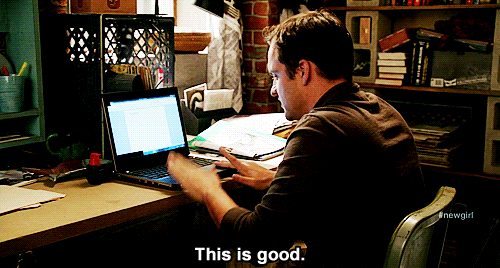Mic Drop: 18 Tips for a Brilliant Presentation
|
Lauren Gilchrist Blogger, Traveler, and Video Talent |
Editor’s Note: This article is part of a two-part series on improving public speaking. Check back next month for part two, when we’ll feature leaders from Skyward districts sharing their best presentation tips.
Imagine two people.
The first is a keynote speaker at an event. She's polished, confident, put together, approachable—a leader.
Now picture a second speaker. He's clearly nervous, mumbling and fidgeting as he plugs along. He's so uncomfortable he's making you feel uncomfortable (you can't wait for the poor guy to be done!).
Need I ask which speaker you'd rather be? The good news is, you can be the first, the keynote. The man in the second example could be too. It all comes down to preparation and practice. Here's how.
Prepare Your Presentation

DON’T: Start at the beginning.
DO: Start at the end. Write your key message you’d like your audience to take away. Then start mapping it out: Where is your audience now? How can you get them from where they are to where you’d like them to be? Make the journey enjoyable and easy to follow (that means nix the jargon and complex industry terminology). When the presentation is over, your audience should leave with a clear, actionable takeaway.
DON’T: Waste the key opening moments.
DO: Start your presentation on a strong note. I recently attended a webinar in which the presenter spent the first six minutes explaining who he was; I was getting distracted before he even got to the content. Your audience will give you a few valuable minutes to capture their attention before they may switch off—don’t waste those moments giving background information. Jump right in with an attention catcher, like an entertaining story or surprising fact, that will get your audience on board right away.
DON’T: Leave out stories.
DO: Tell at least one insightful or emotional story. A few years ago, I was talking to a friend who is skilled at public speaking. He told me stories have two major benefits: 1) They help illustrate your message in a way your audience is more likely to remember; 2) They give your audience a “mental break” and a chance for wandering minds to return. Since he shared that insight, I’ve paid attention during presentations and found that, as an audience member, both are certainly true for me. Using stories within your presentation is fantastic way to engage your audience, but turning your whole presentation into a story? That’s even better!
DON’T: Subject your audience to Death by PowerPoint.
DO: Follow the 10/20/30 rule. At times you may need to go longer, but as a rule of thumb, slideshows should be no more than 10 slides, last no more than 20 minutes, and use a font size of no less than 30. To some extent, anything on a PowerPoint will take your audience’s attention away from you, so be sure the information presented on slides is minimal, enhances your overall message, and helps your audience connect on an emotional level. (A picture is worth a thousand words, but don’t overdo it!) Under no circumstances should you stand in front of your audience and read your slides! If you need to write a lot of information down, do so on a handout and give it out after your presentation. A good slideshow is no use without its presenter.
Prepare Yourself

DON’T: Just wing it.
DO: Practice, practice, practice! Steve Jobs made presenting look easy. But did you know he spent hours rehearsing exactly the words he’d say and the way he’d say them? Practice is key to a smooth, successful presentation. But it must be real practice—not just skimming your notes. Use the same volume, inflections, slides, and props you plan to use in front of a crowd. Film yourself and watch it back. Are you stiff? Fidgety? Talking too fast? Ask someone to watch you present live and give their honest feedback. If you’re including jokes in your presentation, be sure to ask how those are, too—it's better to leave out humor than have it fall flat.
DON’T: Be a camel.
DO: Drink at least 90 ounces of water the day before your presentation and several glasses the day of. If you live in a dry environment, consider running a humidifier in your room the night before. A hydrated voice sounds stronger and more confident than a dry one.
DON’T: Dress too casually. Or too formally.
DO: Dress appropriately for the event and choose an outfit consistent with the message you’re trying to portray. Business casual is generally a safe choice, but depending on the occasion, something more formal may fit the bill. If you look like a respected expert and an approachable leader, chances are, you made a good choice.
DON’T: Skip the warmup.
DO: Include a 5 to 10-minute warmup. Roll your shoulders, massage your neck, breathe from your diaphragm, say tongue twisters, hum scales... Your voice requires muscles and, just like in sports, a proper warm-up is essential to performing your best.
DON’T: Dwell on nerves and insecurity.
DO: Use positive affirmations and envision a smooth, successful presentation. You’ve got this!
Deliver!

DON’T: Speak from your head or your throat.
DO: Speak from your diaphragm. This takes practice, but speaking from your core will make your voice sound more confident and enjoyable to listen to.
DON’T: Forget to pause!
DO: Use pauses effectively. Pauses aren’t empty breaths; they’re tools you can use to draw suspense and emphasize key points.
DON’T: Talk too fast. Or too slowww. Or-like-a-robot.
DO: Speak conversationally. Imagine yourself chatting about your presentation topic with a friend. Chances are, you vary your pace, volume, emphasis, and inflection. When you're giving a presentation, aim to use the same tone and vocal variety. It’s important to put just as much focus on how you deliver your message as you do the message itself. (In practice, recording yourself using various tones of voice, inflections, etc. can be a good way to pick out what works best.)
DON’T: Act like you’re glued to the floor. Or like you’re trying to hit your 10,000 steps.
DO: Move naturally. I learned from an instructor that your hands are the key to looking natural. If you don’t move your hands, your arms and shoulders will tighten up, your neck and body will follow, and even your voice will get tighter. But when you move your hands, that same chain works in reverse: your arms, shoulders, body, and voice will all be more relaxed. Remember, your mouth isn’t the only thing telling the story: use open, confident gestures and body language. Walk around a bit to engage all parts of the room. You’ll appear more comfortable, feel more natural, and connect with your audience better.
DON’T: Hold the mic too close or far from your mouth.
DO: Hold the mic below your chin, parallel to your body. This sweet spot should prevent awkward smacking sounds that can happen when the mic is too close to your mouth, and it should also prevent your audience from having to strain to hear your message. If possible, try out the sound system ahead of time. But remember, bodies in the room will absorb some of the sound, so you may need to speak a bit louder or turn the volume higher than you do in practice.
DON’T: Pull a John Travolta and mess up Idina Menzel’s—or anyone’s—name.
DO: Double check name pronunciations ahead of time. Everyone will appreciate their name being pronounced correctly, especially if it’s often said wrong.
DON’T: Go over your designated time (or way under).
DO: Time yourself multiple times in rehearsal, then stick to that pace when it’s time to go live. If you’ll be able to see a clock or have a stopwatch running, it may help to make notes for yourself: “On slide 6, I should be at 16 minutes.” Most likely, your audience is expecting a presentation of a certain duration. If you go over, you’ll lose their attention to checking their watches or thinking about what’s next on the agenda. Depending on the event, if you go way under, you could also put a wrench in the timing of what’s to come.
DON’T: Forget your passion or the human element.
DO: Be enthusiastic and honest. Show your audience this topic is important to you and explain why it should matter to them. Make eye contact (even if the room is dark, do your best). You’ll build rapport, helping the audience connect with you and your message.
DON’T: Forget to breathe. Or tell your audience, “I’ve never done this before” or “I’m not prepared.”
DO: Be warm, confident, and act like you’ve done this a million times! If your confidence isn’t real, then fake it. Smile, relax, and enjoy the moment. You’ve prepared for this and you’re going to rock it!
Like anything in life, it takes practice to become a comfortable, engaging public speaker. But if you put in the effort, it’ll just be a matter of time before you’re presenting ideas in a clear and entertaining way that leaves your audience feeling inspired.
Mic drop.

Follow-Up Resource: What Does Leadership Really Mean?
Visit skyward.com/lead to check out resources that will help you lead better.Thinking about edtech for your district? We'd love to help. Visit skyward.com/get-started to learn more.
|
Lauren Gilchrist Blogger, Traveler, and Video Talent |
Lauren enjoys visiting school districts and spreading the word about creative, non-traditional approaches to universal challenges. Follow her for on-the-scene reporting (with a little fun sprinkled in) and tips on how to enjoy a better Skyward experience.

 Get started
Get started





